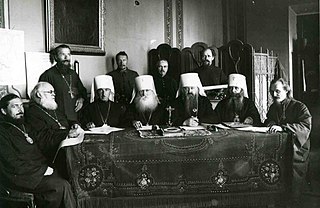This article includes a list of general references, but it lacks sufficient corresponding inline citations. (March 2011) |

Renovationism[1] (Russian: обновленчество, romanized: obnovlenchestvo; from обновление, obnovlenie 'renovation, renewal')—also called the Renovated Church (обновленческая церковь) or, by metonymy, the Living Church (Живая Церковь, Zhivaya Tserkov')[2]—officially named Orthodox Russian Church (Православная Российская Церковь, Pravoslavnaya Rossiyskaya Tserkov'), and later Orthodox Church in the USSR (Православная Церковь в СССР, Pravoslavnaya Tserkov' v SSSR), was the official Christian Church in the Soviet Union from 1922 to 1946, which following World War II was proclaimed as a religious movement that schismed from the Russian Orthodox Church in 1922. Sanctioned by the Soviet authorities, the movement ceased operations in the late 1940s. In 1927, the movement was blessed by the future Patriarch Sergius of Moscow, a political move that enabled the reformation of the modern Russian Orthodox Church in 1943 by Sergius (Stragorodsky).
This movement originally began as a grassroots movement among the Russian Orthodox clergy for the reformation of the Church, but was quickly influenced by the support of the Soviet secret services (Cheka, then GPU, NKVD), which had hoped to split and weaken the Russian Church by instigating schismatic movements within it.[3][4] The beginning of actual schism is usually considered to be in May 1922, when a group of Renovationist clergy laid claims to higher ecclesiastical authority in the Russian Church. Three days after the establishment of the new Church, the Soviet authorities arrested Patriarch Tikhon of Moscow on May 19.[4] Both factions were calling each other names "Renovationites" and "Tikhonovites" (Russian: тихоновцы и обновленцы). The movement is considered to have ended with the death of its leader, Alexander Vvedensky, in 1946, although the last unrepentant Renovationist hierarch, Philaret (Yatsenko),[5] died in 1951.[6]
While the entire movement is often known as the Living Church, this was specifically the name of just one of the groups that comprised the larger Renovationist movement. By the time of the Moscow Council of 1923, three major groups had formed within the movement, representing different tendencies within Russian Renovationism: The Living Church of Vladimir Krasnitsky lobbied for the interests of married clergy; the Union of the Communities of the Ancient Apostolic Church (Союз общин древнеапостольской церкви - Содац SODATs) of Alexander Vvedensky; and the Union for the Renewal of the Church (Союз церковного возрождения) – the group of bishop Antonin Granovsky, whose interest was in liturgical reform; along with several minor groups.
- ^ Мазырин А., свящ. Советское обновленчество: церковный феномен или инструмент госбезопасности? // Государство, религия, церковь в России и за рубежом. 2019. № 1-2. С. 226—248.
- ^ "Renovated Church | Russian Orthodoxy". Encyclopedia Britannica. Retrieved 2021-10-04.
- ^ Robert Service, A History of Modern Russia, from Nicholas II to Putin p 135 ISBN 0-674-01801-X
- ^ a b Фахівець з історії православ'я Сергій Шумило: "Прийшов час золотити не куполи, а наші душі". www.segodnya.ua. 13 April 2019 (in Ukrainian)
- ^ Лавринов 2016, p. 33.
- ^ Лавринов 2016, p. 560.